ON THE QUESTION OF THE TRUE HISTORY OF THE "NEW" COLOURS "GOLDEN COPPER" AND "GOLDEN AKITA" IN THE BRITISH BREED.
The official WCF website states that in order to recognize a new colour in an existing breed, a report is required on the origin, history, genetics and breeding rules of the colour varieties. The corresponding presentation was sent to WCF half a year ago, now the second, updated version is being prepared. And while it is being prepared, I decided to write a few more words myself about the "origin, history." I apologize in advance for using other people's photos of chinchillas without permission – these are not used for commercial purposes, but to illustrate the idea.
Let's start with the fact that "gold with urajiro effect"*1, which has not been able to achieve official recognition in the WCF system for several years, is not something "new". The first cats with this colour were not caught a couple of years ago somewhere in the Carpathians, they were not brought in using another breed, or obtained by genetic engineering or through interspecific hybridization. You can’t even say that it “suddenly appeared,” because, in fact, this colour is the natural result of continued selection of purebred British sires in order to obtain the brightest and purest gold possible without any signs of residual pattern. The effect has been seen before, but is much more noticeable on gold, which is almost devoid of tipping. However, breeders did not immediately pay attention to it or appreciate it, and did not immediately begin to develop it.
For example, one of the most famous first counter-shaded sire was Zur Sternenbucht Golden Macavity (a cat born in 2010, from a father born in 2007 and a mother born in 2006). And if someone thinks that the colour of this cat in that very hazy year of 2010 was "x" or "?", then he is deeply mistaken: Macavity’s colour did not cause the slightest surprise, bewilderment or suspicion of the presence of white spotting in anyone. This cat is BRI ny 12, and it is under that code that he appears in all the pedigrees of his descendants and in all public databases.
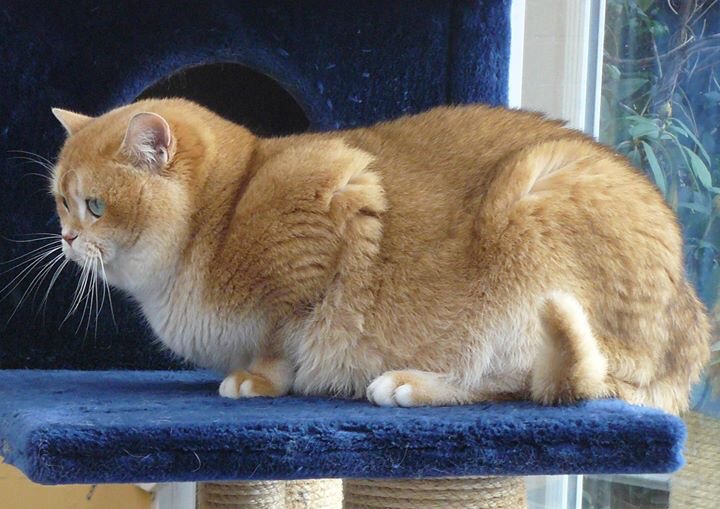 |
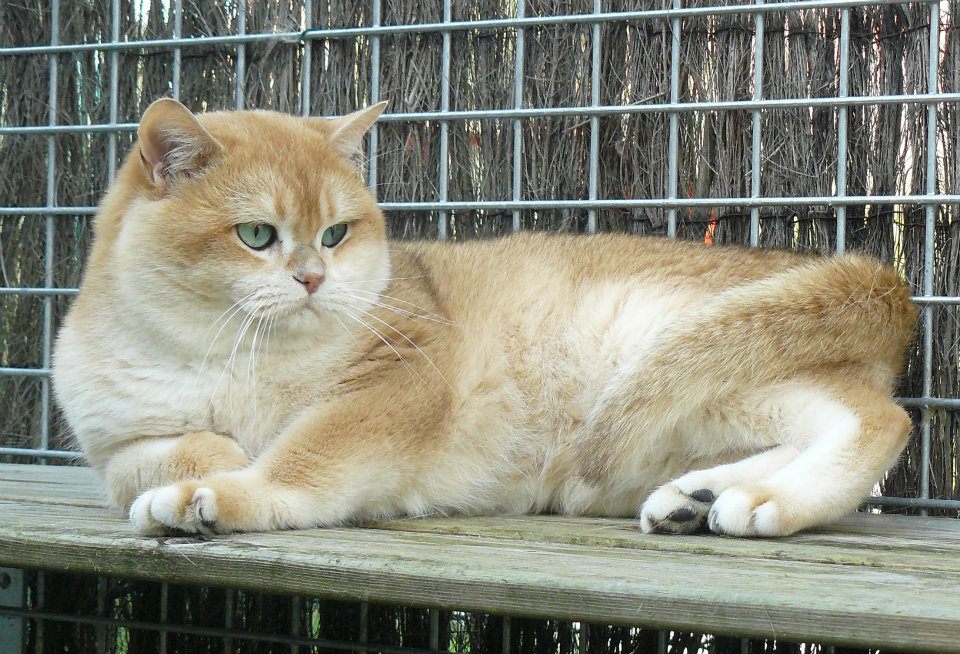 |
|
 |
||
If you wish, you can dig deeper, remembering the no less famous ancestor of Macavity - Marvellous Golden Radetzky, born in 1998. In one of the most famous photographs of him, he deliberately puts forward his "white" toes. Do you think that at least he had a mysterious, unknown colour "x"? Not in the least - according to Radetzky’s pedigree he is BRI ny 25.
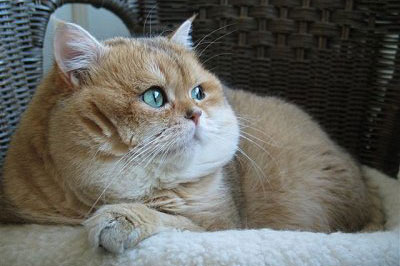
In a word, gold with counter-shading is a very "new, hitherto unseen" colour! You can't imagine anything newer!
Over the past 15 years, many cats exhibiting gold with counter-shading came from the GoldenBri and Galeksy catteries. In these last two cases, cats with this effect have common roots - sires from the Sun & Snow cattery, descendants of the German cat Velasques Rubio d'Oaxaca (born in 2006). Velasques' litter brother Volcano is also the ancestor of many golden chinchillas with counter-shading, for example, he was the grandfather of Lavangi's Golden Kyona, a British LH cat, the mother of a number of graduates of the Galeksy cattery – counter-shaded golden kittens. Kyona herself was also born in 2010 and her lower body is very bright, but then, in 2010, this did not bother anyone.

Eventually the counter-shaded golden effect was noticed and breeders’ opinions were divided. Some really liked this effect and began to select for ever greater purity and contrast of the highlighted areas. Others, on the contrary, reacted negatively to this effect and preferred to conduct selective breeding to reduce the highlighted areas and weaken the contrast. At the same time, both sets of breeders remained unanimous in one thing: the brighter and richer the shade of gold, the closer it is to red and the farther it is from faded, greyish or yellowish, the better.
Today we can say that the efforts of both sets of breeders and others were crowned with success. The breeders managed to achieve two very different variations of the bright golden colour. However, in addition to the typical representatives of both variations (counter-shaded golden cats and golden cats without counter-shading), a lot of "intermediate" variants have survived, for example, golden cats with strong and contrasting highlighting of the toes, but a coloured chest, or vice versa. In addition, it turned out that counter-shading can be characteristic not only of golden chinchillas (ny 12), but also of golden shaded, golden ticked, and golden tabby. True, in ticked and shaded cats, the highlighted areas are usually covered with black tipping and, due to this, judges do not suspect any “white” is hidden beneath the tipping*2. However, it is not these cats that have been the most successful among all types of British golden cats for a long time, but the lightest and brightest golden cats – the chinchillas, which are characterized by minimal (if not completely absent) tipping. There is simply nothing left for them to “dust” their brightened zones with – the eumelanin colour is reduced to a minimum and God forbid that there is least enough for the tip of the tail.
Based on the degree of counter-shading, I divided the golden chinchillas into two types: copper (counter-shading is weakly expressed or almost absent) and akita (counter-shading is strongly expressed). Among the most striking differences, copper may have highlighted fingers, but do not have highlights above the nose, "glasses" around the eyes, and the chest is highlighted unevenly or not at all and looks completely golden. And of course, no one has discounted all manner of intermediate options with which breeders work either in one direction or in another.
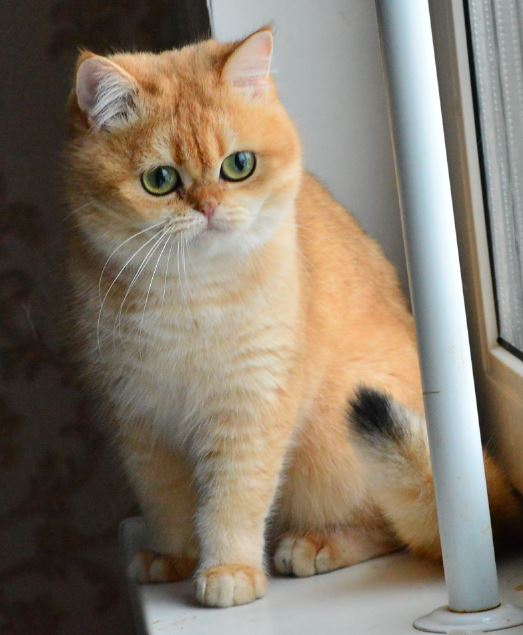 |
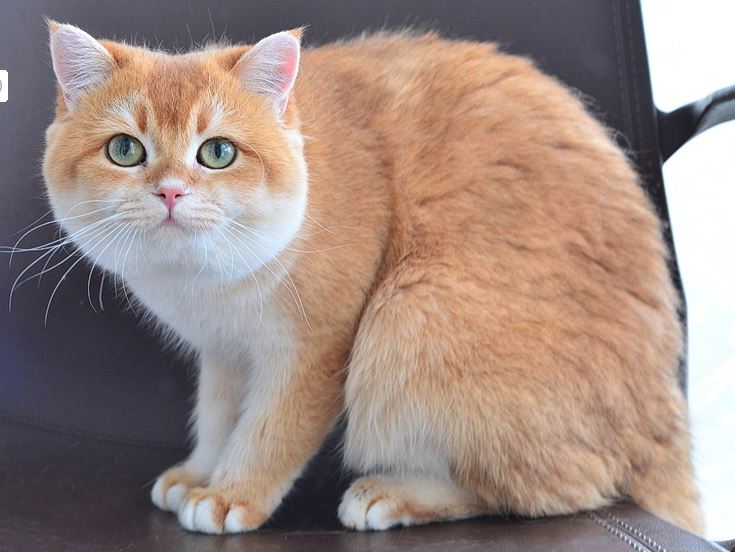 |
For a long time, all variations of minimally tipped gold, including copper and akita, peacefully coexisted under the same colour code, ny 12. But today the difference between them are now so great that it becomes impossible to attribute the same colour code to both of these variations or judge them by the same standard. The standard is a guideline that determines the path of colour development, and the paths for the two variations of gold have become quite opposite to each other. In this regard, it was decided to come up with our own supplementary standard for counter-shaded gold, or at least some kind of encoding of our own that would complement the existing one - for example, nyl instead of the traditional ny. I must emphasize that we are not talking about the recognition of something new or just discovered or previously banned! It is only necessary to supplement the old description, since it does not mention the effect of counter-shading as either an advantage or a disadvantage. Nobody forbade it; it was just that it was not previously noticed and not considered important.
But apparently the breeders didn't have enough problems related to judging copper and akita, because at one fine moment they made themselves another one. A number of quite experienced and well-respected chinchilla breeders (not some beginners who don’t even know themselves who they mated with whom) in breeding together two golden cats suddenly produced kittens that looked like silvers. As they grew, many of them blossomed; some into a kind of clear "gold,” and some into "silver with strong rufism". However, some kittens remained "silver", completely devoid of pheomelanin, and it was often impossible to distinguish them from ordinary silver based on phenotype because there were simply no visual differences. At the same time, many breeding catteries have maintained lines where gold has bred with gold for a long time and have never produced any pseudo-silver kittens from such matings. Thus, this phenomenon, in contrast to the counter-shading effect, was indeed something “new” and “unprecedented” for breeders of British cats, and they first started talking about it relatively recently - around 2018-2019 - when several litters were already sired by the most famous ancestor of "pseudo-silver" kittens, Infinity Jewel Cosmos Golden (born in 2017). Separate reports of such kittens had appeared before, but they were not believed and the breeders were accused of overlooking and allowing a silver cat to be the sire.
Today, the birth of a "pseudo-silver" is no longer a rarity and has become a fairly mass phenomenon, independently discovered in various breeding catteries. Breeders of British cats gave them the name Sunshine. Below are different versions of the British (and related Scottish) Sunshine":
 |
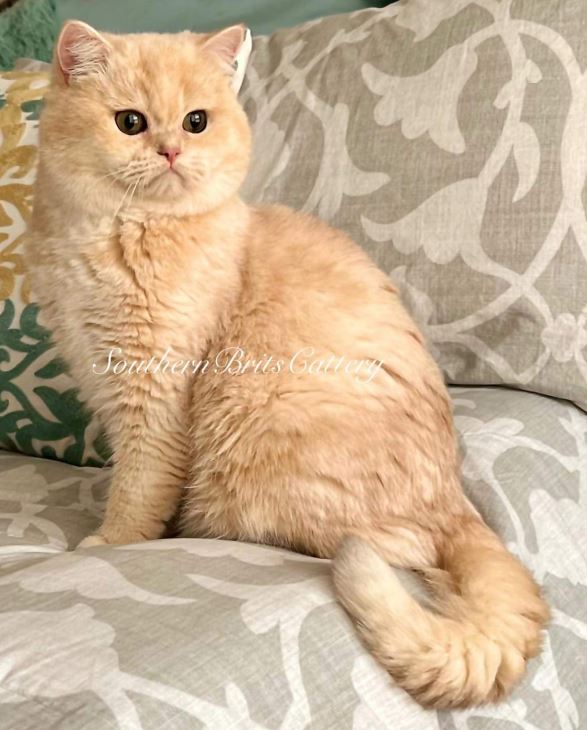 |
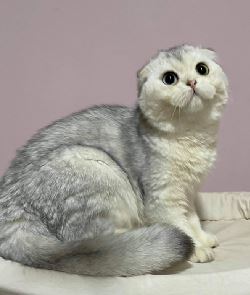 |
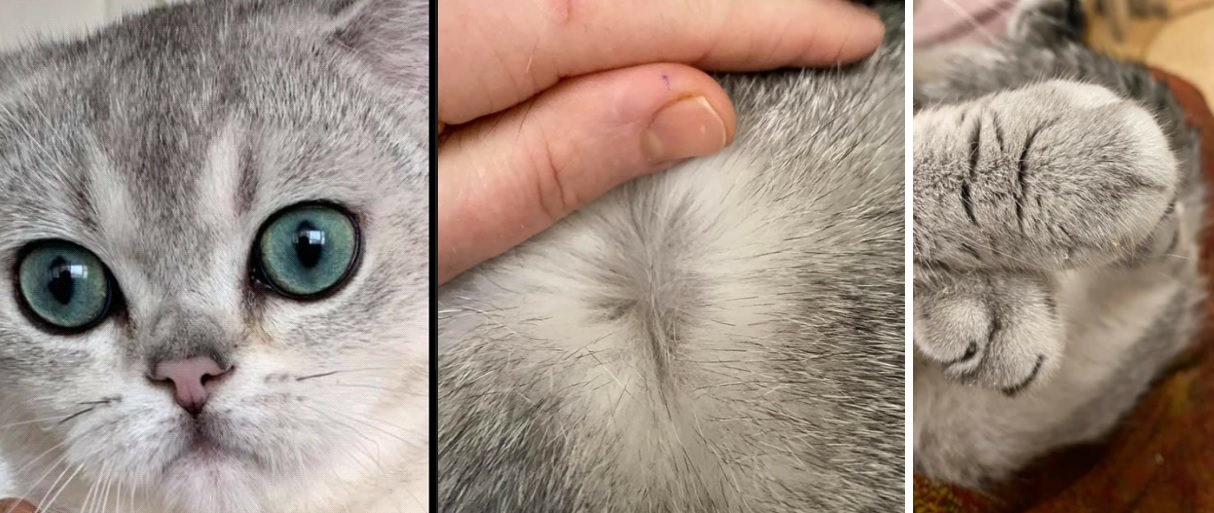 |
||
Breeders of British cats were unaware that this name, Sunshine, had long been "taken" by breeders of Siberian cats, who not only called one of their previously existing colours "sunshine", but also achieved its recognition by the WCF. To do this, they did not need either many years of breeding work strictly within the framework of gold, or a detailed study of the standard for a "new" colour, nor completion of genetic research. It is still not really clear by what principle the CORIN gene (WideBandSIB, aka "sunshine gene"), recently discovered in the Siberian breed, is inherited - is it dominant or recessive, and how, in fact, differs from the "Siberian gold" gene. The golden colour has been known to both breeders and the management of felinological systems for a long time - but so far no “gold gene” has been found in any breed!
The history of the recognition of the "new" colour in Siberian cats is connected with the appearance of a request for the legalization of a colour that was previously considered a "defect": an ordinary silver with rufism, born from matings of silver parents. The newly appeared "sunshine" was attributed the property of partially suppressing the influence of the silver gene, leading to the emergence of "bimetallics" - those very silver cats with strong rufism, which were previously considered "defective" silvers. Now, in order to win high places at shows, it is enough for them to simply declare themselves Sunshine and go to the show in the colour "bimetallic" - nus (21...). The newly emerged Sunshines may even be non-agouti (nu encoding), however, at present no one can say what these nu (sunshine smoke) look like. I was surprised to meet her in pedigrees
Breeders of British cats have not even muttered about the recognition of their Sunshine – something really new, something unfamiliar to anyone until recently and with its unclear method of colour inheritance. They are simply not up to it, given the endless problems with even the ordinary, long-established gold, which was suddenly declared "new", "unrecognized", "unseen" and not worthy of any code except "x" or "?". And this is despite the fact that already several really new, until recently, unseen colours have been successfully recognized - without any genetic research, presentations, standards, show rings, assemblies, and so on and so forth. In particular, a whole series of new "patterns" is practically recognized by WCF: "grizzle ticked" - 26, "karpati" - 28, "roan" – 29. Recently, the "charcoal" colour (which, it turns out, is absolutely no different from the Norwegian amber and therefore is denoted in exactly the same way - by the letter t) has earned a personal code. It seems that among the "patterns" the number 27 is still free - and if the "karpati" pattern with its characteristic white ears and white glasses is already recognized as a "pattern", then maybe it is worth giving the code "27" to the counter-shaded effect which, unlike karpati, has been known to breeders for more than a decade, is much more sought after and thus no less deserving of recognition?*4

A year ago, our club "Feliz" decided to try to find a solution to at least one issue, the simplest problem of British breeders: how to finally achieve official recognition of the long-existing and increasingly popular colour group "counter-shaded gold". For the "copper" variation, it would seem that there should be no problems anyway - their phenotype does not contradict the old colour standard ny 12, whereas the effect of counter-shading is simply not described. Imagine the surprise of the breeders when, at the last few shows in the WCF system, judges, under pain of losing their license, began to withhold titles even from ordinary gold without counter-shading! Against entries in the evaluation sheet "I see that the paws are not white, but I can't give the title because of the WCF letter!"
On May 8, 2021, a large-scale workshop-presentation-ring was held at the Felis club show with the participation of about 30 golden cats, among which were representatives of both types, as well as various intermediate variations. The WCF leadership was informed in advance about this ring and its objectives; was also sent the extensive study material collected by the breeders, including the presentation of the "new" colours, the draft standard, photographs, videos, pedigrees, and genetic tests. And now, after almost a year, it turned out that all these materials disappeared, and the decision on the recognition of counter-shaded golden colours was entrusted to people who have no idea about the essence of the problem and have only just begun to get acquainted with it. These people have nothing to do with British chinchillas, their own felinological interests lie in a completely different direction; they do not know the history of golden British cats, they are absolutely unaware of genetic research that has been carried out for a long time in this direction, they do not distinguish British gold from Siberian sunshine (so it’s not even worth talking about British sunshine with them, at this stage of acquaintance with the topic it will only confuse them). They have not seen any of our presentations, or our photographs, or our pedigrees, they need to be completely brought up to date, from scratch, perhaps for months, on a matter they are not at all interested in! However, we are required to send materials to such people again and again, despite the fact that they have not only not studied everything sent so far, but simply haven’t even seen it in front of their eyes. This happened to the presentation sent half a year ago, and the same fate, apparently, awaits the results of genetic tests, which the WCF demanded and on which breeders spent more than $2,000. We have not received a single comment, not a single question on the tests and pedigrees provided - only more and more new requirements, each of which becomes more absurd.
After the preliminary ring-presentation, Felis planned to hold an official ring-recognition of counter-shaded golden colours at one of the next shows. Representatives of the WCF were invited to this ring in advance, as it should be according to the procedure, and their preliminary consent was obtained. Then the date of the ring was determined and the arrival of two representatives of the WCF was again agreed. However, suddenly one of the representatives, Beverly Elian, announced that she would not come. Our request to either entrust this important mission to another foreign representative, or to entrust it to one of the Russian specialists, was refused. But we were offered he opportunity to hold another "preliminary ring,” motivated by the fact that the previous one, allegedly, was held contrary to some rule that was invented after it was held. I have been looking for this new rule for a long time on the official WCF website in various sections. Nothing was found.
What options remain for us in this situation? Just to get in touch with fellow chinchilla breeders around the world. Is recognition of counter-shaded gold really necessary for Russian breeders only, whose communication with the management of the WCF, among other things, is complicated by the language barrier? Given the huge popularity of our "akita" and "copper", I have no doubt that there are many breeders in Europe, Asia and America who love golden British cats, both with and without counter-shading, as much as we do, and who, at the same time, can freely communicate with representatives of the WCF in their language. Colleagues, it depends only on us whether golden British cats will regain their legal right to participate in exhibitions, win prizes, and receive normal, understandable pedigrees for everyone without any “x,” or “?” or other obscure characters. I ask those who have connections to take the opportunity to directly interact with the leadership of the WCF, to help us negotiate and agree on the ring-recognation, scheduled for June 4-5, 2022, so that justice will finally prevail for our cats.
*1) Urajiro, meaning “undersurface white” i.e. “counter-shading,” is a lightening from underneath and on the sides of the head, on the neck, chest, abdomen, inside of the neck and tail, as well as on the inside of the limbs. Synonym - subclass.
*2) This is exactly what we see when looking at Kyona's toes in the photo above. They are not golden as at the pastern, but at the same time they are liberally dusted with black tipping, so they do not seem to be “highlighted” (which, however, cannot be said about the purest, evenly highlighted chest)..
*3) Footnote by Eleonora Ruggiero: To recognize sunshine in Siberian there was a regular show in Italy and afterwards the new colour was accepted at GA WCF in 2017. The mutation is recessive without any doubt. It is possible to test for sunshine at Antagene laboratory in France. The non-agouti cats are "normal" black, blue etc. The heterozygotes cats for Agouti gene and homozyigotes for sunshine are a little bit different "dark sunshine”... Now we have many siberian cats "copper" and the breeders can't understand the tests because they don't understand the difference between sunshine and copper, similar but different!
*4) By the way, a question for enthusiasts and successful promoters of the new Karpati colour: how many genetic tests for white piebald did they pass and with what result? Did they test for the Birman "white paws"? Have they been tested for agouti? Has the "Karpati gene" been discovered yet, and in what monograph can one read about this epoch-making scientific research? Or is all this required exclusively from breeders of British chinchillas while other colours can be recognized without any costs for genetic research?


